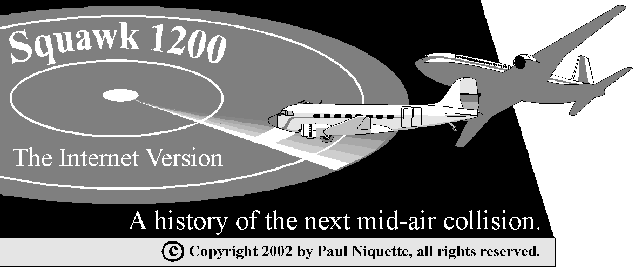Chapter 4
Lottery Aloft
My first assignment at NAFEC
was the independent technical review of the "Dual ILS" (instrument landing
system) scheduled for installation at the then-busiest airport in the world,
Chicago Midway.
The idea was simple enough and enjoyed Henderson's full
support: put in a parallel runway, to double the capacity for accepting
arriving traffic -- to clear out the stacks. The FAA had previously
engaged statisticians to analyze field data from the single landing system
already in operation at Midway. For months, observers were paid to
stand out in the Illinois wheat fields during the worst meteorological
conditions. They stared up into the dank sky and strained to hear
each Chicago-bound airliner as it approached the airport. Thus did
the researchers acquire statistical data from lateral measurements at stations
along the approach course.
As one might expect, electronically guided airliners,
groping their way blindly through the clouds toward the runway, do not
always fly exactly down the centerline defined by the radio beam ("localizer,"
it's called). Some of the data showed a large steering error, particularly
at observation points most distant from the touch-down zone. If two
such guidance systems were to operate side-by-side, those errors could
result in fatal conflicts.
The official analysis, which we were asked to review,
concluded that the Dual ILS would be safe -- that, with a planned runway
separation of 3,600 feet, "there would be no more than one conflict every
40 years."
John McLaughlin, one of our mathematicians looked over
the analysis, giving special attention to the statistical assumptions.
One was crucial -- that the field data fit a "normal distribution."
It permitted simple mathematical interpretation of the data. Accordingly,
all the other results in the FAA's report ramified from that assumption,
including the conclusion of 40 years between collisions. And it was
wrong! McLaughlin rendered the assumption invalid one afternoon by
making a pass over the field data using a desk calculator, performing a
"chi-squared analysis."
"It doesn't necessarily mean the conclusion is flawed,"
said McLaughlin. "Statistically, mid-air conflicts might not happen
for, say, 50 years or even more. The data just does not yield to
'closed form' methodologies."
That was where I came in.
When I was an undergraduate
at UCLA in the early fifties, I worked with Dan Gerlough of the Institute
for Transportation and Traffic Engineering. In one project sponsored
by the State of California, we postulated a hypothetical vehicular metering
systems for freeway on-ramps. You know them today as one-car-per-green
signals ("metering lights," on the morning radio). The idea was counter-intuitive
if not radical.
It raised the question, How do you speed up traffic by
slowing some of it down? Thanks to the SWAC computer at UCLA and
what is called Monte Carlo analysis, Gerlough and I were able to make a
convincing case. The rest, as they say, is history.
That first week at NAFEC, I told McLaughlin about the
Monte Carlo method. He and I wrote a computer program that accepted
the raw field data in the form of spatial "histograms." The program
applied them as numerical templates for a large quantity of simulated aircraft
approaches. Each arrival time and steering error was perturbed randomly
within the constraints of the "model" -- a lottery aloft.
My contribution was limited to writing
a random number generator. The word "software," by the way, was not
yet in wide use, even among computer folk. Hard to imagine there
would be much challenge to create -- or use for -- a program that produces
numbers which have no relationship to anything. Still, my "roulette"
algorithm was picked up as the first of its kind in a paper published in
the proceedings of the fledgling Association for Computing Machinery.
The only computer available to us
was the RW-300, a first-generation machine with a magnetic drum memory.
Slow as it was, we could nevertheless simulate the approach-to-landing
of airliners at the rate of fifteen pairs per second -- 2,000 times faster
than real life.
McLaughlin and I finished checking out the program late
one evening. Our plan was to let the thing run through the night.
That would correspond to a dozen years of rush-hour operations at Midway.
We would review the results in the morning. A few more days of continuous
computing would give us 40 years of simulated operations. I shut
off the lights in the computer room and made for the door.
McLaughlin was waiting for me in the hallway. We
stood for a moment looking through the observation window into the computer
room. Digital technology was as much a marvel to us as to any of
the high-schoolers who often came to our laboratory on field trips to gaze
through that window and observe "giant brains" at work, tirelessly executing
-- oh, my -- thousands of instructions every second. The lights flickered
eerily on the computer panel. John and I turned to leave.
"What's that?" he asked suddenly.
The Flexowriter had come on. It had been powered
up by our program and began typing out a message. With McLaughlin
at my heels, I dashed back into the room and tore the paper off the platen.
We already had our first collision.
Statistical anomaly? Not quite. The next day
there was a small pile of paper on the floor behind the Flexowriter.
Soon, I became absorbed in the design of the computer-driven
displays for the man-machine simulator. McLaughlin wrote the Dual
ILS report and took most of the heat from our client. Weeks later,
the review, which declared that a runway separation of 3,600 feet was not
enough, put NAFEC into an uproar. McLaughlin told me that at the
final show-down meeting, one of the FAA's section managers, a former tower
chief named Henderson, actually said these chilling words: "We asked you
to confirm our results, not challenge them."
So much for the canons of evidence and proposition. |

